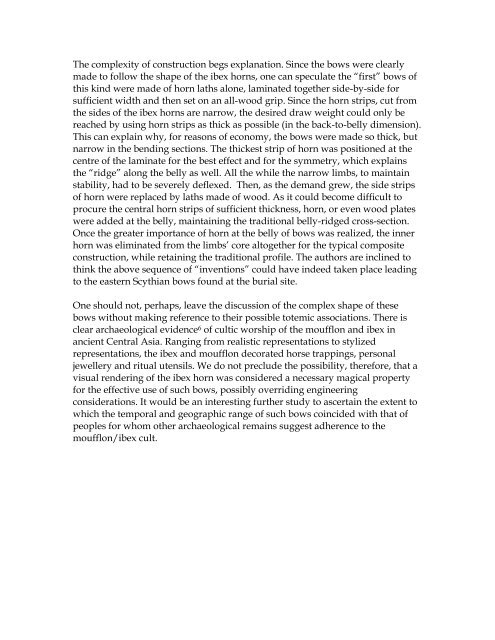You also want an ePaper? Increase the reach of your titles
YUMPU automatically turns print PDFs into web optimized ePapers that Google loves.
The complexity of construction begs explanation. Since the bows were clearly<br />
made to follow the shape of the ibex horns, one can speculate the “first” bows of<br />
this kind were made of horn laths alone, laminated together side-by-side for<br />
sufficient width and then set on an all-wood grip. Since the horn strips, cut from<br />
the sides of the ibex horns are narrow, the desired draw weight could only be<br />
reached by using horn strips as thick as possible (in the back-to-belly dimension).<br />
This can explain why, for reasons of economy, the bows were made so thick, but<br />
narrow in the bending sections. The thickest strip of horn was positioned at the<br />
centre of the laminate for the best effect and for the symmetry, which explains<br />
the “ridge” along the belly as well. All the while the narrow limbs, to maintain<br />
stability, had to be severely deflexed. Then, as the demand grew, the side strips<br />
of horn were replaced by laths made of wood. As it could become difficult to<br />
procure the central horn strips of sufficient thickness, horn, or even wood plates<br />
were added at the belly, maintaining the traditional belly-ridged cross-section.<br />
Once the greater importance of horn at the belly of bows was realized, the inner<br />
horn was eliminated from the limbs‟ core altogether for the typical composite<br />
construction, while retaining the traditional profile. The authors are inclined to<br />
think the above sequence of “inventions” could have indeed taken place leading<br />
to the eastern Scythian bows found at the burial site.<br />
One should not, perhaps, leave the discussion of the complex shape of these<br />
bows without making reference to their possible totemic associations. There is<br />
clear archaeological evidence 6 of cultic worship of the moufflon and ibex in<br />
ancient Central Asia. Ranging from realistic representations to stylized<br />
representations, the ibex and moufflon decorated horse trappings, personal<br />
jewellery and ritual utensils. We do not preclude the possibility, therefore, that a<br />
visual rendering of the ibex horn was considered a necessary magical property<br />
for the effective use of such bows, possibly overriding engineering<br />
considerations. It would be an interesting further study to ascertain the extent to<br />
which the temporal and geographic range of such bows coincided with that of<br />
peoples for whom other archaeological remains suggest adherence to the<br />
moufflon/ibex cult.


